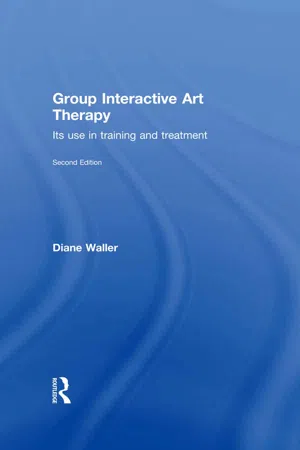
- 204 pages
- English
- ePUB (mobile friendly)
- Available on iOS & Android
About this book
The first edition of Group Interactive Art Therapy presented the first theoretical formation of a model integrating the change-enhancing factors of both interactive group psychotherapy and art therapy, demonstrating its use in practice through a series of illustrated case examples. This long-awaited second edition updates the content of the original in light of the major social, cultural and political changes of the past two decades and presents new examples of the model in practice.
The new edition includes a brand-new section on the use of group interactive art therapy in research with people with dementia, with schizophrenia, and those in rehabilitation from a stroke. The book also features two chapters on the use of the model in a broader context. The book is presented in four parts:
- Introducing group interactive art therapy
- The model in practice: case examples
- The wider context
- Group interactive art therapy used in research
Each section demonstrates the flexibility and adaptability of the model in different cultural and social settings and with a variety of client groups. The development of knowledge about the skills required for conducting an interactive art therapy group and its suitability for different clients has been incorporated throughout the book, as well as practical information on working in areas where there is limited access to art materials.
Frequently asked questions
- Essential is ideal for learners and professionals who enjoy exploring a wide range of subjects. Access the Essential Library with 800,000+ trusted titles and best-sellers across business, personal growth, and the humanities. Includes unlimited reading time and Standard Read Aloud voice.
- Complete: Perfect for advanced learners and researchers needing full, unrestricted access. Unlock 1.4M+ books across hundreds of subjects, including academic and specialized titles. The Complete Plan also includes advanced features like Premium Read Aloud and Research Assistant.
Please note we cannot support devices running on iOS 13 and Android 7 or earlier. Learn more about using the app.
Information
Part I Introducing group interactive art therapy
Introduction
A brief definition of group interactive art therapy
Dr Maria Belfiori (Director, Art Therapy Italiana, Bologna)Fr Mario Picci (President Centro Italiano di Solidarieta, Rome)Juan Corelli (Vice-President Centro Italiano di Solidarieta)Dr Irene Jakab (President of the International Society for the Study of the Psychopathology of Expression and Art Therapy – SIPE, New York)And my husband, Dan Lumley, who had worked with me on many occasions, taking the photographs, leading the art practice workshops and providing a warm and down-to-earth presence.
All the group members and interpreters,Centro Italiano di Solidarieta, Rome,Art Therapy Italiana, Bologna,Inper, Lausanne,Fausto-Sergei Sommer, Bern,Centre for Arts and Therapy, Athens,Medical Academy, Sofia, Bulgaria,Department of Psychiatry, University of Zagreb,Teresa Boronska,Netherne Hospital, Coulsdon, Surrey (photograph of the studio),Nick Tipton (photograph of the Art Psychotherapy Unit hut),Juan Corelli,Nizetta Anagnostopoulou,Professor Mike Crawford and Professor Helen Killaspy, Matisse Group Art Therapy research project,Professor Jenny Rusted and Dr Linda Sheppard, Apollo Group Art Therapy and Dementia research project,Barry Falk, Finlay McInally, Tony Gammidge, Art psychotherapists and researchers,Dr Khalid Ali, Art therapy in stroke rehabilitation research project, members of the art therapy group who made the Juggling Clown image on the front cover, and the film Circus Dreams,My friends Dr Istvan Hardi and Dr Guy Roux whose support and encouragement for the past 30 years has been invaluable.
Chapter 1 Groups and art therapy
Some brief background notes on grouppsychotherapy and art therapy
Table of contents
- Cover Page
- Half Title Page
- Title Page
- Copyright Page
- Dedication
- Table of Contents
- List of figures
- List of plates
- Part I Introducing group interactive art therapy
- Part II The model in practice: case examples
- Part III Developments of the model in social contexts
- Part IV Group interactive art therapy used in research
- Concluding thoughts
- Bibliography
- Index